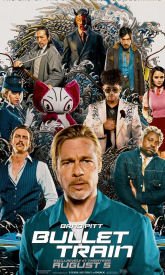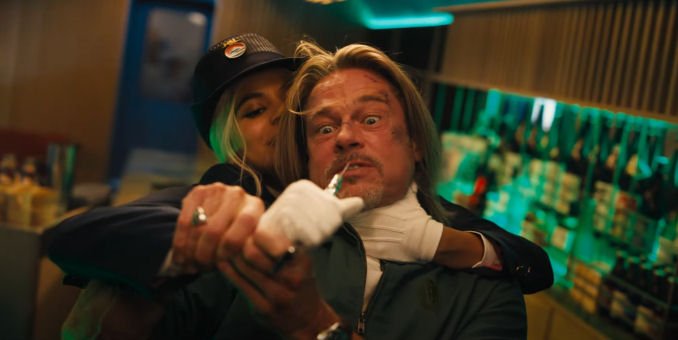
Bullet Train is a the very definition of an old school, summer action film. You take a high concept, sprinkle in enough characterization to make us care about what happens in the numerous action sequences and then you work hard to stylishly shoot the whole thing. And as an old school action film, it certainly delivers plenty of fun and thrills to watch while working your way through a big bucket of pop corn.
Ladybug (Brad Pitt), not his real name, has been working at having a more positive outlook on life, which is tough considering he is a freelance assassin who feels he is plagued by a string of bad luck. Consider his latest assignment – simply stealing a particular metal suitcase off of a Japanese bullet train running from Tokyo and Kyoto. But what should of have been a simple jobnt quickly spirals out of all control as he discovers that there are a number of other killers on the train, each with their own mission. And when those missions start to cross over with each other, mayhem begins.
Bullet Train director David Leitch cut his chops as a stunt man before getting behind the camera to orchestrate the mayhem in Atomic Blonde and Deadpool 2, both films where his stunt background shown through. Bullet Train is no different with a number of sequences that are just as visceral as we’ve seen from him. Where he seems to be amping up his game is in the stylization he brings to his camera work. While it does recall previous work from the likes of Guy Ritchie or Timur Bekmambetov, Leitch utilizes it well, giving the film a visual energy equal to the its titular conveyance.
But all the action sequences in the world – or in this case, the stretch of a two-hour film – mean nothing if there isn’t a good plot to hang them on. And while I can’t speak for the book by author Kôtarô Isaka on which the film is based, screenwriter Zak Olkewicz’s script for Bullet Train is an intricately built, lean piece of writing. It contains numerous twists and turns as characters’ fortunes rise and fall while their storylines collide into or careen off of one another. There is no moment that feels inconsequential. Olkewicz very carefully sets numerous plot elements in front of the audience. Some of which obviously look like they will come into play later while others may just pass by the viewer unremarked upon until they reemerge later. This allows the film to deliver both tensions as the audience sees some things coming into play in the story and pleasant surprises or recognition as others things pop up suddenly. Overall, think of the screenplay as an entire mantle overflowing with an arsenal of Chekov’s guns and you have an idea of the number of moving parts involved.
To be sure, the structure of Bullet Train can at times feel like a throwback to Pulp Fiction or the host of imitators that followed the success of Quentin Tarantino’s landmark film. We have a quixotic lead character looking for a change from his life of violence. We have multiple storylines that weave in and out of each other. We have quick flashbacks that either fill in or reiterate important details as they become relevant. But like Tarantino himself, Leitch has done some mixing and matching with those influences, adding a bit of his own sense of humor for a result that while perhaps derivative is still entertaining.





